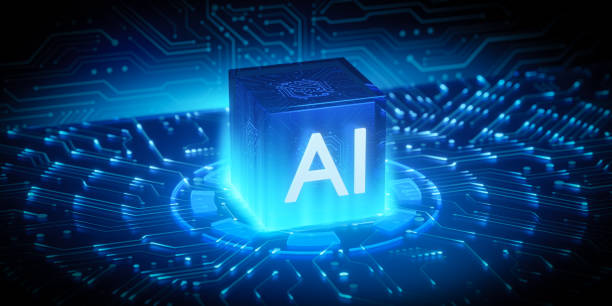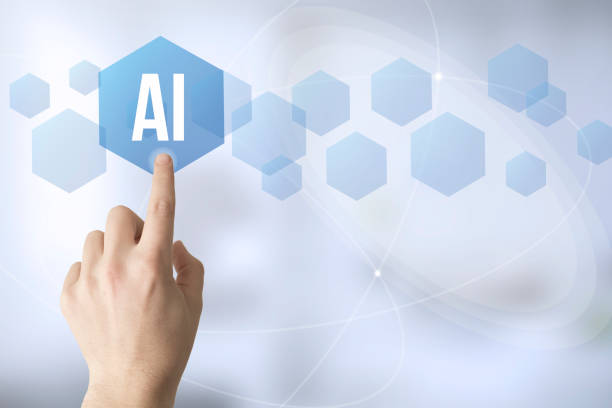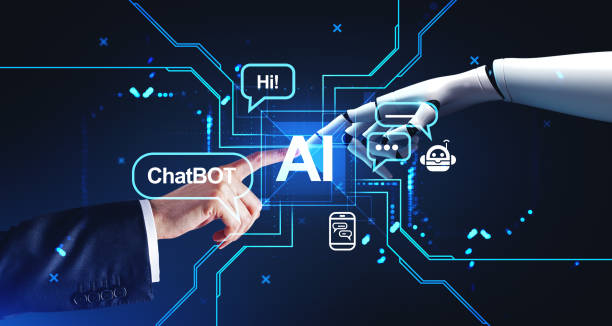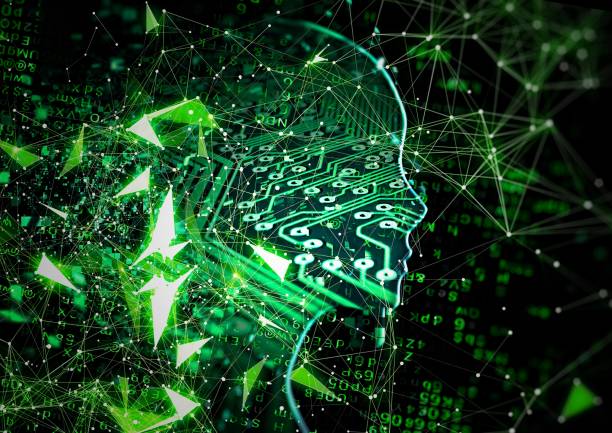What is Artificial Intelligence and what are its applications?

What is Artificial Intelligence and what are its applications?
#Artificial_Intelligence (AI) refers to a branch of computer science that aims to build machines that are capable of performing tasks that typically require human intelligence.
These tasks include learning, problem-solving, pattern recognition, natural language understanding, and decision-making.
Artificial intelligence is no longer a science fiction concept, but a reality that has permeated our daily lives.
From voice assistants like Siri and Alexa to movie and music recommendation systems, all benefit from artificial intelligence.
The applications of artificial intelligence are very broad and affect almost all industries.
In the field of medicine, artificial intelligence can help in disease diagnosis, drug development, and providing personalized healthcare.
In the automotive industry, self-driving cars use artificial intelligence for navigation and decision-making on the road.
In the financial field, artificial intelligence can help in fraud detection, risk management, and providing automated financial services.
Artificial intelligence even plays a role in art and creativity and can help create new and innovative works of art. This power of AI shows why so many companies and organizations are investing in this technology.
Are you tired of your online store not generating as much revenue as its potential? Rasaweb, a specialist in designing professional online stores, will solve this problem forever!
✅ Increase sales rate and revenue
✅ High loading speed and excellent user experience
⚡ Get free consultation on online store design
Types of Artificial Intelligence: Approaches and Differences

Types of Artificial Intelligence: Approaches and Differences
Artificial intelligence can be divided into different categories based on its abilities and different approaches.
One of the most common classifications is dividing artificial intelligence into two general categories: #Weak_AI (Narrow AI) and Strong AI (General AI).
Weak AI is designed to perform specific and limited tasks and performs excellently in that area.
For example, a facial recognition system or a search engine are examples of weak AI.
In contrast, strong AI aims to build a machine that can perform any task that a human can do, as well as or even better.
Strong AI is still in the research stage, and achieving it is one of the major challenges facing AI researchers.
In addition, artificial intelligence can be divided into other categories based on the approaches used.
For example, machine learning is a common approach in artificial intelligence in which machines learn using data and improve their performance.
Other approaches such as expert systems, case-based reasoning, and planning are also used in artificial intelligence.
Understanding these differences helps us to better understand the diverse applications of artificial intelligence and its potentials.
Machine Learning and Deep Learning: Foundations and Applications

Machine Learning and Deep Learning: Foundations and Applications
Machine Learning is a subset of artificial intelligence that allows machines to learn from data without explicit programming.
In fact, in machine learning, instead of writing step-by-step instructions, data is given to machines, and they discover patterns and relationships by analyzing this data, and based on them, they make decisions or make predictions.
Machine learning has applications in many fields, including fraud detection in banking transactions, recommending products to users in online stores, and diagnosing diseases from medical images.
Deep Learning is a subset of machine learning that uses deep neural networks to analyze data.
Deep neural networks consist of multiple layers of nodes (neurons) that are interconnected.
This complex structure allows deep learning to discover more complex and abstract patterns in data.
Deep learning has achieved very good results in areas such as natural language processing, computer vision, and speech recognition.
For example, machine translation and facial recognition systems use deep learning.
Both machine learning and deep learning provide us with powerful tools to use data to solve complex problems.
| Feature | Machine Learning | Deep Learning |
|---|---|---|
| Complexity | Less | More |
| Data Requirement | Less | More |
| Features | Manual | Automatic |
Natural Language Processing (NLP): Understanding and Generating Human Language

Natural Language Processing (NLP): Understanding and Generating Human Language
Natural Language Processing (NLP) is a branch of #Artificial_Intelligence that enables machines to understand and interact with human language.
NLP includes a wide range of tasks, including machine translation, sentiment analysis, text summarization, question answering, and text generation.
For example, Google and Bing translation systems use NLP to translate texts between different languages.
Also, sentiment analysis systems in social networks use NLP to detect users’ attitudes and opinions towards different topics.
NLP tries to model human language using various techniques such as machine learning, deep learning, and linguistic rules.
One of the main challenges in NLP is the ambiguity present in human language.
A word or phrase may have different meanings, depending on the context of its use.
NLP must be able to resolve this ambiguity and recognize the correct meaning.
The applications of NLP are expanding day by day, and it can be expected that in the future, NLP will play a more important role in our lives.
Is your current online store design not generating the expected sales for you?
Rasaweb specializes in designing professional online stores!
✅ Attractive and user-friendly website with the goal of increasing sales
✅ High speed and security for an ideal shopping experience⚡ Get free online store design consultation with Rasaweb!
Computer Vision: Processing and Understanding Images

Computer Vision: Processing and Understanding Images
Computer Vision is a branch of artificial intelligence that enables machines to process and understand images and videos.
Computer vision includes tasks such as object detection, face recognition, motion detection, and 3D reconstruction.
For example, security cameras use computer vision to detect the entry of unauthorized persons into an area.
Also, self-driving cars use computer vision to recognize traffic signs and other cars.
Computer vision tries to extract the information in images and videos using various techniques such as machine learning, deep learning, and image processing.
One of the main challenges in computer vision is the high diversity of images and videos.
Images may have been taken in different lighting conditions, different viewing angles, and with different qualities.
Computer vision must be able to cope with this diversity and extract accurate information.
Computer vision has applications in many fields, including medicine, agriculture, manufacturing, and security.
Recent advances in deep learning have made computer vision a powerful tool for solving various problems.
Robotics and Artificial Intelligence: Collaboration and Future

Robotics and Artificial Intelligence: Collaboration and Future
Robotics and artificial intelligence are two related fields whose collaboration enables the construction of intelligent and autonomous robots.
Robotics deals with the design, construction, operation, and application of robots.
#Artificial_Intelligence enables robots to make decisions, learn, and interact with their environment.
Intelligent robots can help humans in many fields, including manufacturing, transportation, healthcare, and customer service.
For example, production line robots in factories use artificial intelligence to detect defective parts and perform complex tasks.
Also, surgical robots in hospitals use artificial intelligence to perform precise and minimally invasive surgeries.
The future of robotics and artificial intelligence is very bright.
With further advances in these two fields, it can be expected that intelligent robots will play a more important role in our lives.
However, ethical and social issues related to the use of intelligent robots should also be considered.
It must be ensured that these robots are used for the benefit of society and humanity.
Advantages and Disadvantages of Artificial Intelligence: Opportunities and Challenges

Advantages and Disadvantages of Artificial Intelligence: Opportunities and Challenges
Artificial intelligence has many advantages.
It can increase productivity, reduce costs, improve accuracy, and enable the performance of tasks that are difficult or dangerous for humans.
For example, artificial intelligence can help in the early detection of diseases, the development of new drugs, and the provision of personalized financial services.
Also, artificial intelligence can help solve complex problems such as climate change, poverty, and hunger.
However, artificial intelligence also has disadvantages.
It can lead to job losses, exacerbate discrimination, violate privacy, and threaten security.
For example, self-driving cars can cause job losses for drivers.
Also, facial recognition systems can be used to monitor and control people.
To benefit from the advantages of artificial intelligence and reduce its disadvantages, ethical and social issues related to this technology must be addressed and appropriate policies and regulations must be developed.
Also, it must be ensured that artificial intelligence is used for the benefit of all members of society and not just a specific group.
This issue requires careful attention and review by experts and policymakers.
Artificial intelligence is a powerful tool, but like any tool, it can be used for good or bad purposes.
| Advantages | Disadvantages |
|---|---|
| Increased Productivity | Job Loss |
| Cost Reduction | Exacerbation of Discrimination |
| Improved Accuracy | Privacy Violation |
| Solving Complex Problems | Security Threat |
The Future of Artificial Intelligence: What Should We Expect?

The Future of Artificial Intelligence: What Should We Expect?
The future of #Artificial_Intelligence is full of ambiguity and excitement.
It is difficult to predict exactly what will happen, but it can be said with certainty that artificial intelligence will play a more important role in our lives.
It is expected that artificial intelligence will create fundamental changes in areas such as medicine, education, transportation, and entertainment.
For example, artificial intelligence can help develop personalized drugs, provide adaptive education, build safer self-driving cars, and produce more engaging entertainment content.
However, challenges related to artificial intelligence must also be addressed.
It must be ensured that artificial intelligence is used for the benefit of all members of society and not just a specific group.
Also, ethical and social issues related to artificial intelligence must be addressed and appropriate policies and regulations must be developed.
The future of artificial intelligence is in our hands.
With the right decisions, we can use this technology to build a better world.
But with wrong decisions, we may face dire consequences.
Are you disappointed with the low conversion rate of your online store? Rasaweb turns your online store into a powerful tool to attract and convert customers!
✅ Significant increase in visitor-to-buyer conversion rate
✅ Unique user experience to increase customer satisfaction and loyalty⚡ Get free consultation from Rasaweb!
The Impact of Artificial Intelligence on Jobs and the Labor Market

The Impact of Artificial Intelligence on Jobs and the Labor Market
Artificial intelligence will have a significant impact on jobs and the labor market.
Some jobs will be completely automated, while other jobs will require new skills.
For example, jobs such as driving, telephone operation, and data entry may be completely automated.
In contrast, jobs such as data analysis, artificial intelligence engineering, and robot management will require new skills.
To prepare for these changes, you need to keep your skills up to date and learn new skills.
Also, you should look for new job opportunities that artificial intelligence creates.
Governments, companies, and educational institutions should work together to create appropriate educational and support programs to help people adapt to these changes.
It must be ensured that all members of society have equal opportunities to benefit from the benefits of artificial intelligence.
Artificial intelligence can increase productivity and efficiency, but it requires proper planning and management.
Ethics in Artificial Intelligence: Accountability and Transparency

Ethics in Artificial Intelligence: Accountability and Transparency
Ethics in #Artificial_Intelligence is an important and complex issue.
With the increasing use of artificial intelligence, ethical issues related to this technology must be addressed.
Accountability and transparency are two key principles in artificial intelligence ethics.
Accountability means that it must be determined who is responsible for the decisions and actions of artificial intelligence systems.
Transparency means that the way artificial intelligence systems work and how they make decisions must be understandable.
To ensure accountability and transparency in artificial intelligence, appropriate standards and regulations must be developed.
Also, appropriate tools for evaluating and auditing artificial intelligence systems must be developed.
It must be ensured that artificial intelligence systems operate fairly, without discrimination, and with respect for individuals’ privacy.
Ethics in artificial intelligence is an evolving topic and requires ongoing discussion and review.
Experts, policymakers, and the public must work together to reach a common understanding of the ethical principles of artificial intelligence and use these principles to guide the development and use of this technology.
Without attention to ethical issues, artificial intelligence can become a threat to society.
FAQ
| Question | Answer |
|---|---|
| What is the definition of Artificial Intelligence (AI)? | It is a field in computer science that aims to create intelligent machines that can think, learn, solve problems, and make decisions like humans. |
| Mention some common applications of artificial intelligence. | Includes self-driving cars, voice assistants (such as Siri and Alexa), recommendation systems (such as Netflix and Amazon), facial recognition, and medical diagnosis. |
| What is the difference between Narrow AI (ANI) and General AI (AGI)? | Narrow AI specializes in one specific task, while General AI possesses human intellectual ability to perform any cognitive task. |
| What is Machine Learning and its relation to artificial intelligence? | Machine learning is a branch of artificial intelligence that focuses on developing algorithms that allow systems to learn from data without explicit programming. |
| What are Artificial Neural Networks? | They are computational models inspired by the structure and function of the human brain, and are used in deep learning to process data and discover complex patterns. |
| Mention some ethical challenges related to artificial intelligence. | Includes issues of privacy, bias in data and algorithms, job loss, and responsibility in case of errors or unfair decisions. |
| What is Natural Language Processing (NLP)? | It is a branch of artificial intelligence that focuses on enabling computers to understand, interpret, and create human language in a useful and interactive way. |
| How can artificial intelligence affect the labor market? | It can lead to the automation of some routine tasks, requiring the retraining of workers and creating new jobs in the fields of designing, developing, and maintaining artificial intelligence systems. |
| What is Computer Vision? | It is a field in artificial intelligence that enables computers to “see” and understand and interpret images and videos in the same way that humans do, enabling them to recognize objects and faces. |
| What is the importance of data in developing artificial intelligence systems? | Data is the fuel that feeds artificial intelligence systems, especially in machine learning. The quality and quantity of data significantly affect the accuracy and performance of models and their ability to learn and make correct decisions. |
And other services of Rasa Web Advertising Agency in the field of advertising
Smart Direct Marketing: A professional solution to improve SEO ranking with a focus on attractive user interface design.
Smart Social Media: An effective tool for online growth with the help of accurate audience targeting.
Smart Marketplace: A professional solution to increase website visits with a focus on attractive user interface design.
Smart Marketing Automation: A professional solution for analyzing customer behavior with a focus on custom programming.
Smart Link Building: A professional solution for analyzing customer behavior with a focus on Google Ads management.
And more than hundreds of other services in the field of internet advertising, advertising consulting, and organizational solutions
Internet Advertising | Advertising Strategy | Advertorial
Resources
What is Artificial Intelligence (AI)?
,What is Artificial Intelligence and What Are Its Applications?
,What is Artificial Intelligence and What Are Its Applications? (+ Free Training Video)
,What is Artificial Intelligence? Everything You Need to Know About AI
? Transform your business and have a powerful online presence with Rasaweb Afrin, a specialist in comprehensive digital marketing services and personal website design.
📍 Tehran, Mirdamad Street, next to the Central Bank, South Kazeroun Alley, Ramin Alley No. 6




